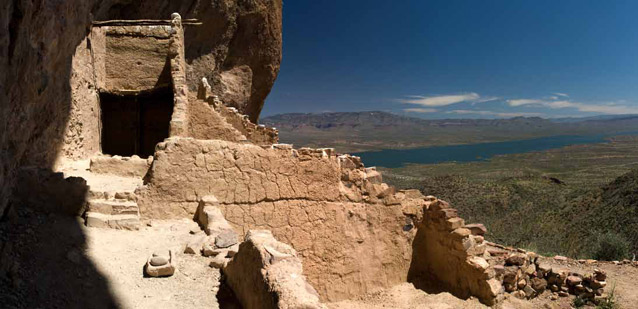The Salado Phenomenon consists of two different patterns - the “Local Salado” culture of the Tonto Basin, and the “Regional Salado” distribution of Salado polychrome ceramics and iconography (Dean 2000). Both patterns date to the Roosevelt and Gila phases of the Late Classic period, and in the Tonto Basin, these phases reflect the core of Salado culture in the region.

NPS
The Roosevelt Phase (A.D. 1250-1350) in the Tonto Basin was characterized by small hamlets and villages with shallow pit structures. Small platform mounds - structures lacking local precedents - were centrally located within the communities and were the center of religious, political, and ceremonial life (Reid and Whittlesey 1997). Specialuse sites, such as field houses and camps for gathering and processing resources such as wild plants or game, were dispersed across the landscape away from the hamlets and villages. Farming was conducted using irrigation canals, floodwater fields with check dams, and dry farming. Cotton was grown and woven into products that were possibly traded for items such as ceramics and shell from other regions. Pinto Polychrome ceramics were common during this time, as were Tonto and Salado Corrugated utilitarian wares and Pinedale Polychrome and Cedar Creek Polychrome pottery from the neighboring Mogollon (Elson 1996). Local Salado treatment of the dead included both cremation and inhumation (burial) during this phase.
The Gila Phase (A.D. 1350 to 1450) saw major changes in settlement patterns. Most lowland platform mound and upland communities of the Roosevelt Phase were abandoned near the end of the Roosevelt Phase (Reid and Whittlesey 1997). The populations aggregated in a small number of large settlements, including Tonto Cliff Dwellings in Tonto National Monument, and Cline Terrace and Schoolhouse Point along what is now Lake Roosevelt. Gila and Tonto Polychromes were made during this time, and were widely traded and emulated across a large area of the southern Southwest (Simon et al. 1998).
During both phases, Salado people constructed and lived in platform mound communities. Platform mounds supported structures for housing people as well as activities representing communal support for social, political, and religious leadership. The communities surrounding these platform mounds appear to have been stratified societies in which elite and non-elite membership was indicated by burial treatment (Dean 2000). Evidence suggests that the power differential between the elite and non-elite members of these communities was neither great or absolute, and that even elite members did not accumulate significant amounts of wealth (Dean 2000). The platform mounds of the later period were larger, however, with more substantial walls and fewer access points, suggesting a need for defense to some archeologists (e.g., Reid and Whittlesey 1997).
Complex, hierarchical communities like those observed from the Late Classic Period in the Tonto Basin, are characteristic of larger societies. However, the low population estimates in the Basin suggest that complex, hierarchal communities are sustainable with fewer people than previously believed (Dean 2000). Some researchers think that the Tonto Basin communities were organized into “confederacies” around irrigation systems by elite social connections (Dean 2000). Competition and conflict between these confederacies could explain the more defensive locations and organization of the latter-period sites, including the Upper and Lower Cliff Dwellings of Tonto National Monument.
Part of a series of articles titled Salado Overview.
Previous: What Does Salado Mean?
Last updated: August 14, 2017
